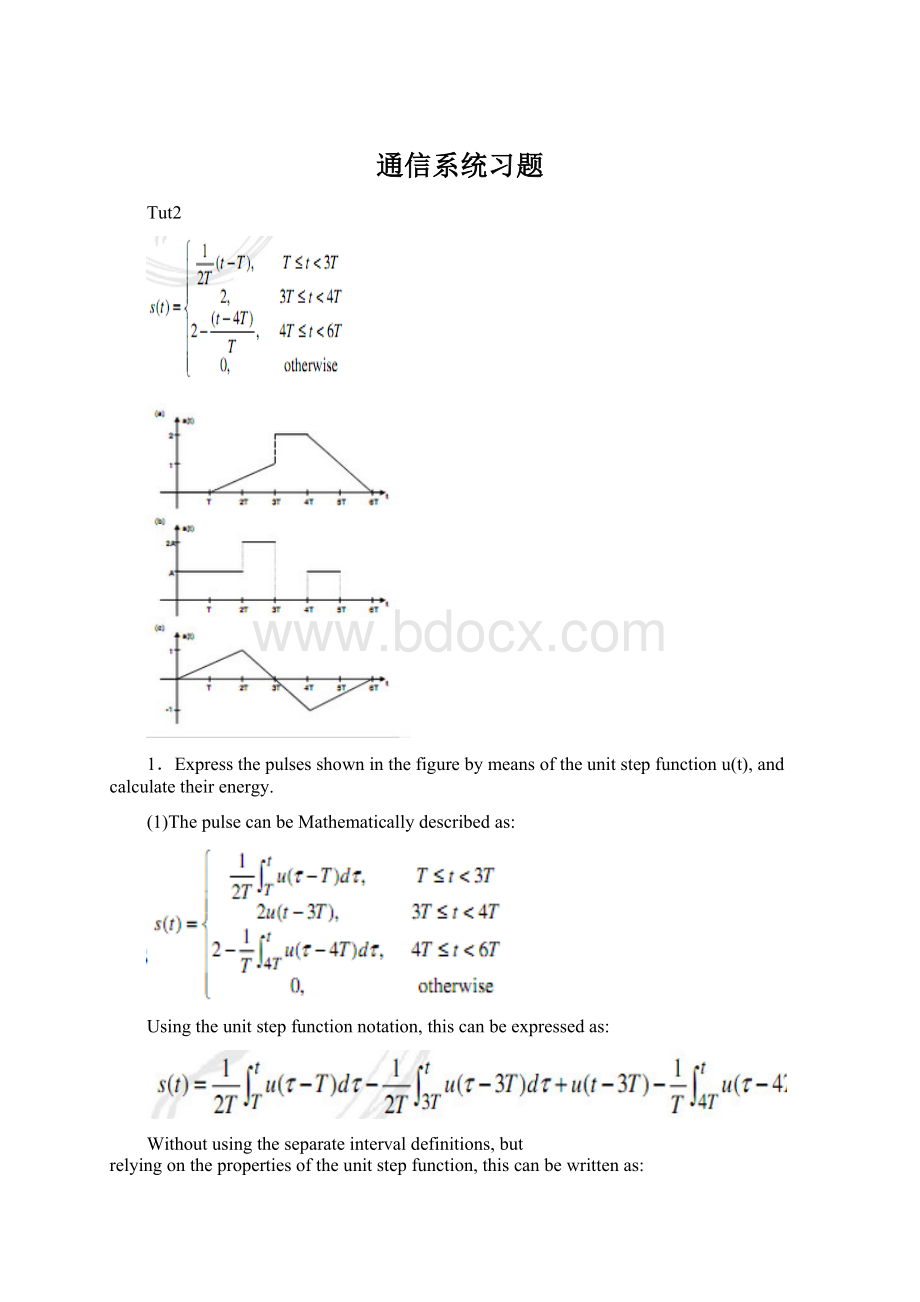 通信系统习题.docx
通信系统习题.docx
- 文档编号:8988874
- 上传时间:2023-02-02
- 格式:DOCX
- 页数:35
- 大小:1.87MB
通信系统习题.docx
《通信系统习题.docx》由会员分享,可在线阅读,更多相关《通信系统习题.docx(35页珍藏版)》请在冰豆网上搜索。

通信系统习题
Tut2
1.Expressthepulsesshowninthefigurebymeansoftheunitstepfunctionu(t),andcalculatetheirenergy.
(1)ThepulsecanbeMathematicallydescribedas:
Usingtheunitstepfunctionnotation,thiscanbeexpressedas:
Withoutusingtheseparateintervaldefinitions,but
relyingonthepropertiesoftheunitstepfunction,thiscanbewrittenas:
Thepulseenergyisdefinedas:
Tofindthevalueofthisintegral,wecandivideitinto3separateintegralswithlimits[T,3T],[3T,4T],[4T,6T],respectively.Hence,theenergyisgivenby:
(2)Thepulsecanbeexpressedas:
Intermsoftheunitstepfunction,
thiscanbewrittenas:
Thepulseenergyisequalto:
(3)Thepulsecanbeexpressedas:
Intermsoftheunitstepfunction,this
canbewrittenas:
Andtheenergyisequalto2T.
2.Evaluatethefollowingintegrals
3.Findtheoutputofthetime-invariantlinearsystemhavingtheimpulseresponseh(t)shownintheFigure(a),inresponsetotheinputsignalx(t)presentedintheFigure(b).
Inordertocalculatetheconvolutionx(t)*h(t),weneedfirsttofindthemirroredversionofthesignalx(t),changethevariabletoλ,i.e.findx(-k),aspresented
Thatmirroredversionoftheinputsignalisthenshiftedandsignalx(t-λ)isconsidered.
Itisclearlyvisiblethatfort<3thesignalx(t-k)andtheimpulseresponseh(t)donotoverlapforanyλ.
Hencetheintegraloftheirproductisequaltozero.
Thedifferentoverlappingpossibilitiesareillustratedinthefigure,andfinallyfort>7,x(t-λ)andh(t)stopoverlappingforanyλ
Therefore,theoutputsignaly(t)canbeexpressedas:
Afterperformingintegration,weget
Theobtainedoutputsignaly(t)isplottedbelow.Itisworthtonoticethatthesignaly(t)issmootherthantheinputsignalx(t),andthatthetimelimitspropertyholds.
4.Determinetheauto-correlationfunctionofthefollowingsignal(whereA>0):
Solution:
Thewaveformis
shownasfollows
Firstlynotethattheautocorrelationofarealfunctionisalwayssymmetric-thusyouonlyneedtodeterminetheshapeoftheautocorrelationforr<0orr>0.Secondly,notethatthetime-shiftedimageofthetriangularpulsedoesnotoverlaptheoriginalfunctionatallifr>Torr>-TThereforetheautocorrelationiszerointhoseregions.Wecanjustworkouttheautocorrelationfunctionfor0 Thisintegralistrivialtoevaluate,whichgivesyou Theleft-handsideisjustamirror-imageoftheright: youcansubstitutet=-tintoEquation3toderivethis: Thusthefullexpressionfortheautocorrelationis ThisisshowngraphicallyinFigure2. 5.Determinetheauto-correlationfunctionofthesignal giventheauto-correlationfunctionofaperiodicsignalx(t)isdefinedas: whereTistheperiodofthesignalx(t) Solution: Tut3 1.FindtheFourierseriesexpansionofthetriangularwaveform Thecyclicallyrepeatedpulsecanbeexpressedas: withtheboundariesoftheinterval【a,b】being-0.570and0.5T0,respectively. Thecoefficientsaredeterminedby: Thepulsex(t)isanevenfunctionoftime,soforany valuesoftandnwithintheconsideredinterval Therefore, whichresultsinallcoefficientsbnbeingequalto0;n 1,2,.... Thecoefficienta0equalsto Thisresultfollowsdirectlyfromthefactthata0representsthed.c.term,whichisclearlyequalto0intheconsideredcase. Forothervaluesofn,n=1,2,...,wehave Thefirstintegralwithinthebracketsequalstozeroforanyvalueofn,asweintegratetherecos(x)functionoveranintegernumberofperiods. •Thesecondandthethirdtermsareofthesameform,andcanbecomputedusingtheformula Hence,weget •Thelatestmeansthat Exampleplotsofthe truncatedFourierseries expansionforthe triangularwavefor (a)3terms, (b)5terms, (c)50terms 2.FindtheFouriertransformoftherectangularpulse anddrawitsmagnitudeandphasespectra. FromthedefinitionofFouriertransform,wehave Hence,theW(f)isarealfunctionoffrequency.Thisisanexpectedresult,becausethew(t)isaneven functionoftime. Thusthemagnitudespectrum|W(f)|isexpressedas: TofindthephasespectrumΘ(f),letusfirstconsiderthefactthatforittobeandoddfunction,wemusthave Therefore,0(f)=0ifW(f) >0and0(f)=±kn„otherwise;kisanodd integer. Inaddition,sincew(t)isarealsignal,0(f)=-0(-f). 3,FindtheFouriertransformofthesocalled'radiopulses'w1(t)andw2(t)definedas: •TheFouriertransformW,(f)canbefoundsubstitutingw(t)=n(t)and0=0intothemodulationtheorem.Thissubstitutionyields: •Forw2(t),weneedtotake0=-0.5π,whichresultsin: 4.FindtheFouriertransformoftherectangularwavew(t)showninthefigurebelowanddrawthemagnitudespectrum|W(f)|inthefrequencyrange-300Hzto300Hz. TofindtheFouriertransformofthewavew(t)wewillusetheformula Therefore,weneedfirsttofindtheFouriertransformofthepulseh(t)whichisrepeatedatregularintervalstogeneratethewavew(t). Thepulseh(t)isarectangularpulsewithawidthT=10ms Thepulsesh(t)arerepeatedeveryT0=30ms. Hence,assumingthattimetisinseconds,thewavew(t)canbeexpressedas: anditsFouriertransformW(f)isgivenby: wherethefundamentalfrequencyf0=1/T0=33.333Hz,and/-/(f)istheFouriertransformofasinglepulse •FromthetableofFouriertransforms SubstitutingthisintotheformulaforW(f)yields: BecausethedifferenttermsofthesumintheformulaforW(f)donotoverlap,wecantakethemagnitudeof|W(f)|asequaltothesumofthemagnitudesofdifferentterms. Theweightsofimpulsesforf=nf0;n=0,±1,±2,canbepresentedintheformofatable Weightsofspectrallinesforthemagnitudespectrum|W(f)| •Plotofthemagnitudespectrumofthewavew(t) Tut5 1.Amixerisusedtomultiplytwosignalsx(i)andy(i).Plotthemagnitudespectrumoftheoutputofthemixerif whereA=2mV,fm=2kHz,B=1mVandfc=200kHz.Repeatyourconsiderationsifthemagnitudespectrumofx(i)isasgiveninFig.1,andy(i)isthesameaspreviously. Solution: Inthefirstcase,themixer'soutputz(i)isgivenby: Utilizingthetrigonometricidentity: weget: Because thelatestcanberewrittenintheform Substitutingthenumericalvaluesfortheconstantsyields: andthemagnitudespectrumofz(i)isgiveninFig.2. Figure2: Magnitudespectrumofwaveformatthemixer'soutput. Tofindthemagnitudespectruminthesecondcase,weneedtoutilizethefrequencytranslationpropertyofFouriertransform,whichstates Intheconsideredcase,0=0.Themagnitudespectrumofthez(i)isgiveninFig.3. Figure3: Magnitudespectrumofthez(i). 2.Drawthemagnitudespectrumofthesignalxout(t)attheoutputofanon-lineardevice,havingacharacteristic: Assumethattheinputsignalconsistsofasumofabasebandsignalandacarrierwavehavingitsfrequencymuchhigherthanthemaximumfrequencyinthebasebandcomponent.Repeatyouranalysis,assumingthatthebasebandsignalsoftheform: Solution Inthefirstcase,theconsideredinputsignalxin(i)isgivenbytheequation: wherem(i)isabasebandsignal.Substitutingthistotheformulafortheoutputvoltageofthenon-lineardeviceyields: Utilizingthetrigonometricidentity: weget: Theplotofthemagnitudespectrumofxoui(i)isgiveninFig.4. Figure4: Plotofthemagnitudespectrumattheoutputofanon-lineardeviceiftheinputsignalisasuperpositionofasinusoidalwaveoffrequencyfcandthesignalm(t)havingthe magnitudespectrum|M(f)|. Inthesecondpartoftheproblemthexin(t)isoftheform: Withoutthelossofgenerality,letusassumeherethatthiscorrespondstothesituationwherethesignalm(t)consideredinthepreviouscasehasamagnitudespectrumasshowninFig.5. Figure5: Magnitudespectrumofthesignalm(t)composedof twosinusoids. Allofthederivationsperformedforthefirstpartoftheproblemareexactlythesameinthispart.However,thesignalm(t)isnowoftheform: Therefore,tofindallthespectralcomponentsofthesignalat theoutputofthenon-lineardevice,weneedtoworkoutthe spectralcomponentsofSubstitutingthepreviousequationfora2m方(t)weget: Theplotofthemagnitudespectrumofthexout(t)isgiveninFig.6,andthemagnitudesofthespectralcomponentsarelistedinTable1. Figure6: Magnitudespectrumofthexout(t). Table1: Magnitudesofspectralcomponentsforxout(t). 3.Considerapulsew(t)giveninFig.l,andmultiplyitbyasinusoid Istheresultingwaveformabase-bandoraband-passwaveform? Iftheresultingwaveformisaband-passone,finditsband-passrepresentationintermsof: thecomplexenvelopeg(t),therealandimaginarypartsoftheenvelopex(t)andy(t),themagnitudeoftheenvelopeR(t)andthephaseΘ(t). Solution Theresultingwaveformisgivenby: Todetermineifitisabase-bandorband-passwaveform,oneneedstocheckitsmagnitudespectrum.Itcanbecomputedusingtherealsignalfrequencytranslationtheorem[Couch]. Applicationofthattheoremyields: whereW(f)denotestheFouriertransformofthepulsew(t)derivedinthepreviousexample.AsitisvisibleinFig.3,themagnitudeofWf)decaysrapidlywithincreaseoff,andwecanconsiderwithaverygoodaccuracythat
- 配套讲稿:
如PPT文件的首页显示word图标,表示该PPT已包含配套word讲稿。双击word图标可打开word文档。
- 特殊限制:
部分文档作品中含有的国旗、国徽等图片,仅作为作品整体效果示例展示,禁止商用。设计者仅对作品中独创性部分享有著作权。
- 关 键 词:
- 通信 系统 习题
 冰豆网所有资源均是用户自行上传分享,仅供网友学习交流,未经上传用户书面授权,请勿作他用。
冰豆网所有资源均是用户自行上传分享,仅供网友学习交流,未经上传用户书面授权,请勿作他用。


 《Java程序设计》考试大纲及样题试行.docx
《Java程序设计》考试大纲及样题试行.docx
